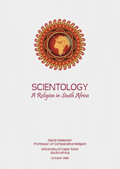The Founding Church of Scientology was formed as a religious society in Washington, DC, on 21 July 1955 for “the propagation of the religious faith known as Scientology, and to act as a Church for the religious worship of that faith.” Over the next thirty years, the Church of Scientology expanded dramatically to become a global religion. Like any religion, the religion of Scientology is anchored in specific places of worship. The social organisation of the international Church of Scientology is based on a hierarchy of five different types of religious centres.
First, Scientology missions provide introductory services and auditing to the level of Clear. Although missions are primarily engaged in outreach to people who are unfamiliar with Scientology, they also are authorized to deliver all the basic “routes to the Bridge.” When a mission achieves a sufficient size, it can become a church.
Second, Scientology churches provide all the auditing, training, and other religious services available at the missions. However, churches also offer advanced training for auditors and have the authority to ordain ministers. Regular Sunday services are held.
Third, Saint Hill Churches and Advanced Organisations are religious centres for advanced auditing and training. Located in Sussex, Copenhagen, Los Angeles, and Sydney, these centres specialize in the religious technology for achieving the initial levels of Operating Thetan.
Fourth, the Flag Service Organisation, located in Clearwater, Florida, is the spiritual headquarters for the international Church of Scientology. The centre provides all Scientology religious services, including the higher levels of training as Operating Thetan and the highest degree of training for auditors.
Fifth, the Flag Ship Service Organisation, which conducts its services on board the Freewinds, a 440-foot ship based in the Caribbean, is the only Scientology centre that offers the highest level of auditing. In addition, the Flag Ship Service Organisation provides special courses and religious retreats for spiritual advancement.
This hierarchy of religious centres functions under the authority of the Mother Church in Los Angeles, the Church of Scientology International. Responsible for preserving and propagating the Scientology religion, the Church of Scientology International has established several subsidiary divisions. Golden Era Productions produces and disseminates a wide range of publications, films, and recordings. Two publishing companies—Bridge Publications in Los Angeles and New Era Publications in Denmark—handle the publication of the books of L. Ron Hubbard. Although it looks like a modern corporate structure, this ecclesiastical organisation serves religious interests by overseeing the preservation and expansion of the religion of Scientology all over the world.
In addition to preserving and propagating its religious technology, the Church of Scientology has developed a range of public services in the fields of drug rehabilitation, criminal reform, business administration, and education.
Dedicated to the preservation of the church’s sacred scriptures and religious teachings, the Religious Technology Center registers and supervises the use of Scientology trademarks and copyrights. In guarding the orthodoxy of the religion, the Religious Technology Center maintains the purity of its teachings and ensures that the ministry of the church is conducted on an ethical basis.
Outside of the church hierarchy, the Church of Spiritual Technology was established in 1982 to ensure the survival of the religion by preserving the writings of L. Ron Hubbard on imperishable materials. Indicating that these writings are regarded as sacred scriptures, the Church of Spiritual Technology has developed various means of preservation, including inscribing Hubbard’s texts on stainless steel plates to be stored in titanium containers, that will guarantee the permanent survival of the foundational documents of the Scientology religion. In this way, the Church of Spiritual Technology has assumed the responsibility of protecting the sacred scriptures of Scientology from “any conceivable catastrophe in order that future generations, even wandering tribes of savages thousands of years from now, will have the Scripture to resurrect the religion.”32
In addition to preserving and propagating its religious technology, the Church of Scientology has developed a range of public services in the fields of drug rehabilitation, criminal reform, business administration, and education. Narconon provides services and support to reduce drug use; Criminon works with convicted criminals to keep them from returning to prison; the Way to Happiness programme supports the development of personal morality and social ethics; and Applied Scholastics provides educational programmes in studying and learning methods. Through these and other programmes, the Church of Scientology extends its religious mission into social services.
The central focus of the Church of Scientology, however, remains its religious mission. As L. Ron Hubbard intended, Scientology has been planned on a religious organization basis throughout the world. Not all “new religious movements” have been so comfortable with being identified as religions. For example, Transcendental Meditation, founded by Maharishi Mahesh Yogi, insisted that it was not a religion; it was a secular organisation that offered a purely scientific technique for stress reduction.33 But Scientology has always been clear about its status as a religious organisation. That status has been affirmed all over the world by governments that have granted the church the same legal recognition and tax exemptions accorded to any religion.





























